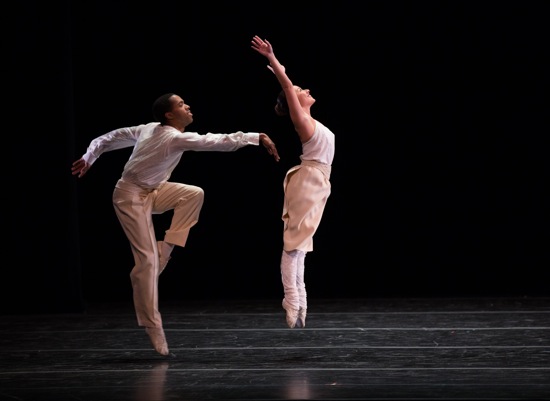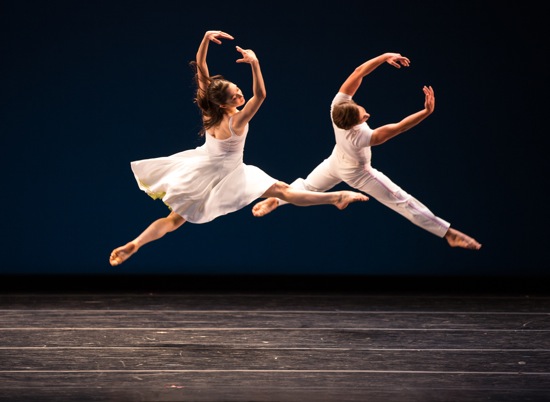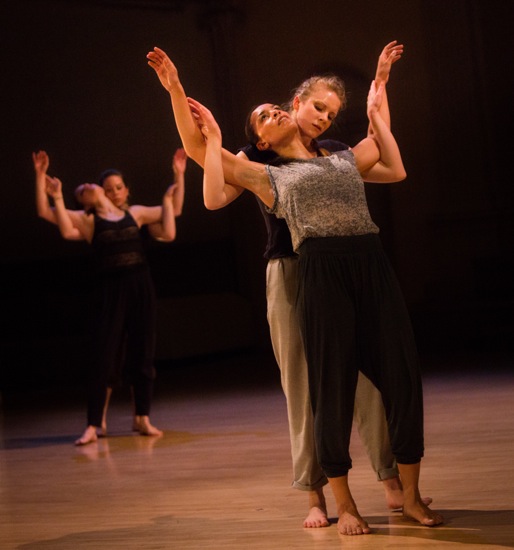Juilliard Dance presents works by Tharp, Lubovitch, and Feld. Suzanne Beahrs Dance performs at Danspace.

Juilliard students Leiland Charles and Brittany Hill in Twyla Tharp’s Baker’s Dozen. Photo: Rosalie O’Connor
I count Twyla Tharp’s Baker’s Dozen among the world’s great dances. When I saw it in 1979, performed by her marvelous company, I thought I’d die of pleasure. How could I not hustle uptown to see Juilliard Dance’s annual challenge to its super-talented students, when Baker’s Dozen was opening a program that included Lar Lubovitch’s Concerto Six Twenty-Two (1986) and Eliot Feld’s The Jig Is Up (1984)?
Every spring, Lawrence Rhodes, the artistic director of the Juilliard Dance Division, gives the students the opportunity to fit themselves into important, already established works. Former Tharpie (or is it Tharpist?) Shelley Washington staged Baker’s Dozen, which must have helping the performers to get the wonderful piano pieces of Willie “The Lion” Smith (arranged by Dick Hyman) wriggling and jittering and slinking through their bodies and making their feet jab the floor and slide over it. That pianist Christopher Ziemba played the music brilliantly added tremendously to the pleasure of seeing this work brought to life by the terrific young dancers. No, they couldn’t surpass Sara Rudner, Richard Colton, Rose Marie Wright, and all those in Tharp’s company during its heyday, but the cast I saw (there were two) danced with style, wit, and understanding.
Tharp shows us the twelve performers in Baker’s Dozen as if they were facets of a prism that’s turning in various ways to refract and reflect the sun’s rays. It’s not just Jennifer Tipton’s clear, beautiful light that reveals the dancers; the sunny music, as it ripples along or pounces on a tango rhythm, further illumines the men in their white pants and shirts and the women in their suavely draped dresses (costumes by Santo Loquasto.
In tune with the piece’s title, the choreography plays with numbers. And with the delights of pairing in a boy-for-every-girl world. Six couples fly onto the stage one by one. Each set of partners dallies long enough to engage in unheard conversations with their mobile bodies, swinging arms, and busy feet. The movement is tricky, sly, rich in its variety of rhythms and dynamics. A lot of choreography today doesn’t make you think, “Oh boy, dancing!” Tharp’s does. We could never rise from our seats and do what they do, but we feel hints of that movement sneaking into us.
From couples, Tharp moves into coming-and-going trios. A hint of unserious jealousy may crop up, but really, three can play more intriguing games than two. The pianist moves into “Tango à la Caprice.” A new man leaps in to disrupt a trio, and, lo, quartets multiply all over the place. One is thrillingly fast, another more lyrical. Unison is a rarity. Not so in the ensuing sextets; sometimes squads of six dancers cross the stage in perfect synchrony; at another moment, six go crazy.
People keep popping out of the wings, then change their minds and disappear again. One woman, held high out of sight, literally falls for the partner who has been waiting for her. Another woman starts to enter, and invisible hands yank her back offstage by one leg. As Baker’s Dozen accumulates, it also re-introduces us to individuals. All twelve dancers snake around the stage in a procession that resembles an unbuttoned polonaise: a couple of steps and a third in which they stretch one leg forward and sink into the rhythm. As they go, they keep disgorging individuals who drop into brief solos. In the end, we’re back to just two people, who take hands and saunter out smiling.

Daphne Fernberger (L) and Lorrin Brubaker in Lar Lubovitch’s Concerto Six Twenty-Two. Photo: Rosalie O’Connor
Lubovitch’s Concerto Six Twenty-Two also employs twelve dancers dressed in summery white clothes (these by Anne de Velder), and Craig Miller’s lighting suggests the outdoors. But these people dance to Mozart’s ravishing Concerto for Clarinet, K. 622, played by the Juilliard Orchestra under the excellent leadership of Karina Canellakis, with Weixiong Wang as the soloist.
Lubovitch starts the “Allegro” with eight of them dancing buoyantly in a circle, as if this were a fete in a village populated by uncommonly nimble and buoyant folks. The mood is celebratory. Two women have a brief moment of dancing, two men show off for them, then those four stand by and watch while the other two women show what they can do. The remaining two men arrive, swing those women in the air, then set them down and dance for them. The circle pulls them in again. The movement is fluid, springy, earthy yet windblown; it exudes joyousness. I like seeing these Juilliard dancers perform this opening movement of Mozart’s concerto almost more than when dancers in Lubovitch’s company performed it. Perhaps that’s because they’re so young and fresh that the occasional perky, edging-toward-cute moves suit them, and, in staging Concerto Six Twenty-Two, Katarzyna Scarpetowska has coached them to make everything look easy and unaffected.
The heart of this major work of Lubovitch’s is its duet for two men, set to Mozart’s profoundly beautiful Adagio. The dancers that I saw, Robert Moore and Dean Biosca, performed wonderfully, with all the gravity and calm that the choreography demands. This section is often programmed by itself, and at the height of the AIDs epidemic, it eloquently expressed the resignation and the live-for-the-moment tenderness that we saw all around us in the 1980s. Whether we take the men to be lovers or simply close friends, it’s possible to feel deeply what their dancing for each other or together conveys.
In the last movement, Lubovich, like Tharp in Baker’s Dozen but in a different manner, creates a traveling group structure in Concerto Six Twenty-Two, out of which individuals drop to dance happily alone for a few seconds before being swept up again into a line that stretches from the front of the stage to the back and keeps passing back and forth from one side to the other. It’s a comforting image.
If Tharp’s work and Lubovitch’s keep the dancers tracing big, fluid patterns on the space. Feld creates intricate phrases of movement in which a lot of action happens while not much ground is covered. The Jig Is Up, like many of the pieces that Feld began to make in the 1980s, is grounded in repetition. If the dancers perform a step you really like, don’t worry, you’ll get to see it many, many times. And when the steps are unusual—as they most often are— I can get interested in them all over again. Feld disbanded his last company some time ago, and I’m glad that Rhodes has several times programmed his work.
Willa Kim’s costumes are a little bit too raggle-taggle-gypsyish for me, but they do tell us that this group is rustic rather than elegant. The recorded music by the Bothy Band and John Cunningham turns Irish music into something that, although lusty, also falls in with Feld’s passion for repetition. When the fourteen dancers enter in a line that zig-zags through the space until it brings them into a circle, you can memorize the way they lean into a forward step, pushing with their hands, and turn to slant into a backward walk, fluttering their hands behind them.
As restaged by Feld, Patrice Hemsworth, and Jaquelyn Scafidi, the piece is a challenging showcase for these up-for-anything dancers. Amanda Mortimore and Jeffery Duffy face each other holding hands and turn their connected arms into a wheel as they heel-and-toe along. In their duet Corwin Barnette and Michele Carter show us over and over how he can hoist her periodically to sit pertly on this thigh as they travel together. Gemma Freitas, while treading softly, turns her feet in and out and crooks one leg around the other; she looks as if she were knitting the choreography. Kristina Bentz, her long hair loose and flying, stamps her feet as she circles her body around and around, priming a passionate motor before she can move out into space and kick up a leg. The men roister together, and Corey John Snide and Nobel Lakaev wend their way toward stage right tossing Taylor Hansen high and catching her between them in a way that makes me wince. Finally, Feld re-introduces almost everything we’ve seen since the dance began and has it happen all at once. It’s an exhilarating collage of The Jig Is Up on fast rewind.
Dancers who are still students brings to mind three choreographers who were, a number of years ago, graduate students I knew at New York University’s Tisch School of the Arts. Summation Dance Company, directed by Taryn Vander Hoop and Sumi Clements, gives its fourth season at the Brooklyn Academy of Music’s Fishman Space April 2 through 5, and Suzanne Beahrs Dance appeared for the first time at St. Mark’s Church through Danspace Project’s DANCE: Access program, March 27 through 29.
Beahrs’s new Amid lasts just under an hour and floats on what amounts to a musical patchwork quilt. Would anyone imagine a progression from the gorgeous Andante from Bach’s Italian Concerto, through Dominco Scarlatti’s Stabat Mater, a song by Caetano Veloso, Tuvan throat singing, a Keith Jarrett ramble, and Osvaldo Golijov’s Mariel? These must be selections that mean a great deal to the choreographer, and, for the most part, one segues pretty smoothly into the other, with the helpful addition of the sound of waves and other natural phenomena.
One of the most impressive things about this group of five women is how beautifully and sensitively they perform together—aware of the space around them and attentive to the details and nuances of the movement. In a press release Beahrs revealed that she loves breaking out in dance whenever she’s alone in an elevator. That playfulness and zest for movement infuse her opening solo in Amid. We hear waves lashing the shore as she begins. Her personal style juxtaposes small, sharp moves to bigger, more sensuous ones. She performs as if thoughts were passing through her; she may skitter rapidly, then pause, pull herself together, and change course. The air around her and the floor draw her attention. Designer Brittany Spencer situates her for most of this in light from only two instruments two light, so she is often in shadow.

(L to R): Celine Syslo holding Madeline Wilcox , Julia Jurgilewicz holding Sarah Hillmon. Photo: Yi-Chun Wu
Beguiling though it is, the solo seems slightly long, because its interplay of dynamics proceeds with few changes in its overall structure. The four women who enter from each corner of the nave (Sarah Hillmon, Julia Jurgilewicz, Celine Syslo, and Madeline Wilcox) adapt the movement in Beahrs’s solo to their own double duets, unison passages, and one versus three images. They too follow rapid steps and gestures with slower ones. Eventually all five women are dancing—now to the Stabat Mater; they fall to the floor, crouch, and roll. Coming together, separating, and reuniting become the ingredients of obvious theme. Jurgilewicz performs a solo in silence; she’s riveting. No wonder it takes the others a while to copy her steps, and they do so gradually.
There are hints of moods. When Hillmon’s colleagues copy her sweeping steps, they do so with what appears to be trepidation. Wilcox and Jurglewicz huddle and press their cheeks together. When, after sounds that could be those of sleet and thunder die away, Syslo, lying on the floor, performs by herself in a spotlight, Hillmon, Jurgilewicz, and Wilcox stand grouped on one of the church’s carpeted platforms and stare down at her. She lifts her head off the floor and gazes at them, then rises slowly to join them, as a guitar announces the beginning of Veloso’s “Cucurrucucu Paloma.”
Beahrs, a gifted up-and-coming artist, has appended a note to Amid’s program. It says: “Amid is a celebration of the exquisite power in our broken, impermanent selves.” As the women go through their impeccable, meticulously rehearsed patterns, they show us many generous, finely shaped steps—flinging these through space, springing up, scooping up air, raising their arms high. But as Amid, progresses, I realize what we’re not seeing. Except for one in-passing moment, we don’t see diversity in action. We see finely engineered synchrony and counterpoint, stillness and motion. But we do not ever see five individuals performing different phrases at the same time. We do not ever see the five collaborating closely on an effort that brings them into close contact. In other words, it’s difficult for us to understand, however fleetingly, what they overcame in order to celebrate.







You make all these works sound delicious, but I truly envy you the Baker’s Dozen — I haven’t seen it in years, but the memory of it, when the company was first touring with it, eclipses many other dances I’ve seen more often and more recently. Must be spring fever!